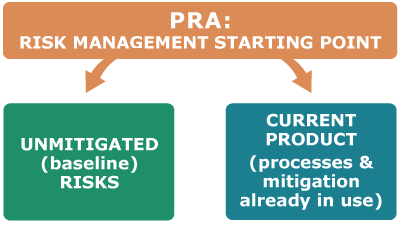Lesson 1: Risk Management Theory and Background
Topic 4: Hazard Identification and Risk Management
When conducting a PRA, there are three general subjects to focus your research on: pests, pathways or policies. Always remember that it is important to be specific when identifying the hazards associated with these three subjects. This topic will also help you consider hazards associated with normal industry practices, so that you can be more informed about the next steps in the pest risk management process.
Objective:
- Understand the principles of identifying hazards for pests, policies and pathways.
Relationship Between Risk Management and Hazard Identification
In Topic 1 of this lesson, Figure 1 showed how the risk assessment process begins with the initiation stage and the identification of hazards. This is where you describe the concern that has created the need for a pest risk analysis (PRA). The risk management process begins with identifying possible phytosanitary measures (steps to keep plant commodities free from pests or diseases) that can be used to mitigate the risks associated with the hazards.
Before moving on to a more detailed examination of risk management, let’s review the procedure for identifying hazards. This review will provide a clearer understanding of the relationship between risk management and hazard identification, and stress the importance of being careful from the beginning of the PRA.
In general, you conduct PRAs when you want to examine the following:
The hazards in each of these analyses have unique characteristics that will affect both risk assessment and risk management. The key point to remember is to be as specific as possible in identifying hazards.
Watch the following video for an example of how to consider normal industry practice when identifying hazards.
Choose the Starting Point for PRA: Risk Management
After the commodity or pathway (along with any relevant processes and actions) is clearly described, it is time to choose the precise starting point for the PRA. This starting point might be the unmitigated (baseline) risk. In the case of lemons or tangerines that may or may not have stems, the analysis would be for any lemon or tangerine from the country of origin—with no assumptions about cultivation or handling. If you are looking at changes to an existing program, the starting point might be the current product, including any processes (such as culling and washing) and mitigation measures (such as cold treatment) that are already performed.

The key is to establish a baseline for risk according to the description of the product and the objective of the analysis. This means that anything done through risk management to change the risk will be new or additional and focused on the risk associated with the commodity. It is important to precisely document any changes in how the commodity is treated or handled and any assumptions and uncertainties.
Negotiation of Measures
Recall from Workshop 3 Market Access that once you decide on a mitigation plan, you must negotiate a final proposal with the trading country. This often happens in one of two ways:
- Exporting NPPO evaluates proposal from importing NPPO and provides counterproposal.
- Exporting NPPO provides proposal to importing NPPO, which evaluates it and provides counterproposal.
To continue, select Topic 5 from the Topics menu above or click here.